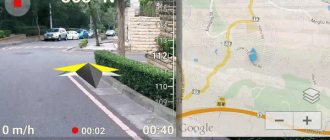A modern mobile device is equipped with a touchscreen, accelerometer and other sensors that significantly increase the functionality, comfort and attractiveness of using the hardware and software tools of the Android operating system. These adjustment-sensitive elements require precise adjustment or reference to a custom coordinate system, otherwise the device will not work correctly. From time to time you have to configure pressure sensors, proximity sensors, brightness sensors, GPS, battery, etc. The user must know how to calibrate the sensor on Android.
Display calibration
Screen calibration refers to the adjustment of the pressure sensor to ensure correct command processing. The sensor must respond to finger touches clearly and quickly. However, performance may deteriorate over time and when this becomes noticeable, calibration is recommended. The procedure is quite simple and should be carried out:
- regularly - once every 2-3 months;
- mandatory - after sticking the protective film, if moisture gets inside and replacing the display.
When and why do you need screen calibration?
The user practically does not think about calibrating the screen until working with the device becomes uncomfortable. The need for calibration is quite easy to determine. So, if the sensor on Android is faulty, you need to press harder on the screen and keyboard buttons.
Also, certain areas of the screen may respond differently to touches. When the keyboard produces an adjacent letter instead of one, this is also a sign of the need for calibration. This problem slows down the work with the device and sometimes causes irritation.
Sometimes cleaning the protective glass will help fix everything. But if the problem appeared after the device fell, correction of the touchscreen on Android is required.
Even minor damage can cause the sensor to malfunction and the screen will not respond as quickly as before.
In this case, you need to remove the film from the display and check the sensitivity to pressure, the correctness and convenience of keyboard input.
Device Application
Having decided what an accelerometer is in a phone, it’s worth finding out how to use it - here are a few examples:
The sensor is used to control games - changing the position of the mobile device causes certain actions on the part of the game character or the vehicle controlled by the player. For example, by tilting your phone you can change the direction of a car in racing simulators.
Rice. 4. The game Asphalt 8, which is controlled using the accelerometer.
During sports jogging, the accelerometer is used in smartphones and tablets to monitor the distance traveled. This determines the approximate number of steps taken - and although the error can be quite high (depending on the speed of movement), the results obtained can be used to improve training results.
The presence of such sensors on smartphones and tablets allows you to change the orientation of the image. By placing the mobile gadget horizontally, the user, using the accelerometer, automatically receives a landscape format of the picture or text. When the screen is positioned vertically, the orientation will change to portrait.
Other devices use the sensor to perform the same tasks that require an accelerometer on phones, and for other purposes. Thus, in aviation it is necessary for the operation of navigation systems, and in industry it is used as a vibration transducer.
In HDD hard drive management systems, an accelerometer is required to compensate for vibrations caused by object accelerations and to protect the data stored on the drive.
DVRs using this sensor are able to determine the time of acceleration and braking, record stops and collisions. On game console joysticks, the accelerometer is necessary to control the gameplay.
Sensor calibration: detailed instructions
Android OS has enormous functionality, including a long list of flexible settings. Software sensor adjustment is no exception. If the sensor slows down, the user can correct the situation in two ways:
- Using special software.
- Manually using Android tools.
It is worth saying that all smartphones and tablets running this OS have an almost identical calibration algorithm. In addition, sensors have recently become more reliable and more unpretentious to operating conditions: while previously resistive sensors were widely used, today only capacitive ones are used, which are characterized by higher quality and reliability.
Manual setup
Before you begin the procedure yourself, it is worth finding out where the screen calibration is located, namely in which section of the settings you can find the function responsible for this process. As a rule, not every smartphone and tablet has an open function for screen calibration. Moreover, it is almost impossible to do this manually at home.
On some devices, screen calibration is available in the Screen or Display section menu. If your device has it, to configure the sensor, you need to do the following:
- Open "Settings".
- Enter the “Display”, “Screen” or “Phone Settings” section depending on the model.
- Place the gadget on a flat horizontal surface.
- Select “Calibration” and activate the process.
- Dots or crosses will appear in several areas of the display, which should be pressed exactly in the center and with the force that you want the sensor to “remember”.
Then you need to restart the gadget and make sure it is functional and correct input and response to screen taps. If there is no such option in the settings, then the display of the Android device is calibrated through the engineering menu.
This is a special mode in which a smartphone or tablet is able to accept special commands for fine-tuning. If the menu entry is not blocked by the manufacturer, it is almost identical for most devices, although the key combinations may differ slightly. The necessary information is in the instructions or on the manufacturer’s website. Please note that this option is suitable for advanced users.
Using special programs
When there is no calibration function in the device, and you don’t want to mess with the engineering menu, you can try to use special software. The choice of free applications in the official Google Play store is complicated only by their incredible number. However, the maximum they can do is show the display status and display the number of clicks.
At the same time, there are programs that can easily conduct a screen color test for an Android device and much more, but this requires root access. In any case, it is recommended to read reviews, pay attention to the rating, and inquire about the latest app updates before downloading. If a utility has not been supported by the developer for a long time, it is unlikely to live up to expectations.
Installing such software is no different, as is the procedure described in the attached step-by-step instructions. Some applications require root access, which can be obtained using a PC.
Contacting service
This is a last resort measure, which is often needed in case of mechanical damage to the display or if the gadget gets into water. If you can’t adjust the sensor yourself, professionals will help you. They will change it if necessary.
Operating principle of the sensor
A user who first encounters the term “accelerometer” in the list of smartphone characteristics may be interested in what it is, how it works and what it looks like. Answering these questions is not difficult - the device, named after the Latin word “accelero” (“accelerate”), is used to measure apparent acceleration.
By determining this parameter, the sensor helps the software control the position of the phone in space and the distance to which the mobile gadget has been moved.
Meanwhile, even knowing what an accelerometer is, some users do not distinguish it from a gyroscope. In fact, both sensors can measure the same values, but cannot completely replace each other.
In this case, the gyroscope in the phone is necessary to determine the angle of rotation of the gadget relative to a certain plane. And an accelerometer is required to control position in space by measuring the acceleration of movement. Sharing devices helps the gadget's software get more accurate results.
Rice. 1. One example of how an accelerometer works.
Considering the action of the accelerometer and what it is by and large, it is worth getting acquainted with the principle of operation of the classic device:
- Why the proximity sensor does not work on Honor and Huawei: reasons and what to do?
- The main part of the sensor is an inert mass (for example, a weight) attached to an elastic element.
- An elastic part such as a spring is fixed on a stationary element.
- The spring is fixed on a stationary part of the structure.
- Load vibrations are suppressed by a damper.
- When tilting, shaking and turning the gadget, the inertial mass reacts to the force of inertia.
- The greater the intensity and force of tilting, shaking or turning, the more the spring is deformed.
- After the mass returns to its place under the influence of the spring, the level of displacement relative to the normal position is recorded by a special sensor.
Rice. 2. Design of a standard accelerometer.
On the other hand, the answer to the question about the accelerometer in the phone – what it is and what it looks like – will be slightly different. In this case, it is a miniature element on a board with an inert mass located inside and usually looks like a small black square.
Setting up the G-sensor
The accelerometer, or acceleration (overload) meter when moving the device, is responsible for the functionality of several important applications at once. So, without it, the pedometer, screen rotation function and even GPS in offline mode are impossible. And for game lovers, without such a function, the gadget becomes unnecessary, so setting up the g sensor on Android after replacing the display is mandatory.
However, problems do not always appear after breakdowns requiring repair.
Sometimes the functionality of the G-sensor leaves much to be desired due to software glitches, and in such cases the owner can try to figure out the problem on his own.
You shouldn’t look for such an option in the settings, but using third-party software or the same engineering menu would be useful. On some models, checking the screen for dead pixels, the operation of communication modules and the accelerometer is quite simple. If you dial *#0*# on your phone, a window will appear in which you can easily check using the corresponding button.
Using the GPS Status&Toolbox program
With this utility, checking sensor and GPS data, position and strength of satellite signal, speed and acceleration, altitude and battery status is no longer a problem. This is an almost universal program for checking the sensor on Android, although it is supported only from the fourth version of the OS.
GPS Status&Toolbox is a free application, which at the same time has flexible tools, including a magnetic compass, the ability to share location, align and set marks, as well as quickly reset and download A-GPS data for quick correction of readings.
To calibrate the accelerometer and gyroscope of a tablet or smartphone using this software, you need:
- Download GPS Status&Toolbox to your device.
- Open the program.
- Go to the “Tools” menu and select accelerometer calibration.
- The program will ask you to place the gadget on a flat, smooth surface and confirm the action with the “OK” button.
- Then the utility will ask you to specify one of three actions: “Reset”, “Calibrate”, “Average”. After selecting the second one, the G-sensor will be configured.
After completing the procedure, it is recommended to restart the device for the new settings to take effect.
Using the Engineering Menu
It is worth clarifying that the method is suitable for devices based on MTK processors. On all other models, the engineering menu is not supported. Under normal conditions, with a working device, accelerometer calibration is rarely required.
As a rule, games and other programs that work with the g-sensor have their own settings. If the gyro sensor refuses to work, you can correct the dysfunction in the engineering menu. This requires:
- Turn off the device and enter the mode, which does not work on all models of mobile devices. Find out if this is possible in the instructions or on the manufacturer’s website. Often, the desired mode is activated by simultaneously holding down the volume down and power keys. To enter the engineering menu you need to dial *#*#3646633#*#*; on some devices there may be other commands: *#15963#* or *#*#4636#*#*. For devices with MTK processors, you can use the MobileUncle Tools and MTK Engineering applications.
- By moving through the menu using the volume buttons, you should find the “Hardware Testing” section, and then select “Sensor” in it. The action is confirmed by the power button.
- Place the gadget on a horizontal surface, then go to the “Sensor Cal” section.
- There, you first need to select “Clear Calibration” to remove old data, and then select “Do Calibration (20%)” (usually required three times).
Calibration is completed, all that remains is to find and select “Reboot” and confirm the reboot with the power button.
How to calibrate your compass
A compass is a useful tool for travelers and hunters who do not want to get lost in the forest and can easily navigate with it. But what to do if the compass does not work or shows the wrong direction? The solution is simple! It is enough to do the calibration using the program.
To check all sensors for functionality, you should download and install the program. Go to the main menu by clicking on the upper left corner and select “Sensor diagnostics”
. On the contrary, each sensor will have either a green check mark, indicating serviceability, or a red exclamation mark, symbolizing a possible malfunction of a particular sensor.
The instructions presented in this article may help those who are faced with faulty sensors on their devices. If you have any questions, we will be happy to answer them in the comments below the article.
Many owners of Android devices with a touch screen often encounter a problem when the screen “does not listen to them.” That is, when you touch the touchscreen with your finger or stylus at one point, the phone perceives it as a touch at a completely different point. Or the sensor completely carries out orders only after 3-4 attempts. And most likely the cause of these problems is the incorrect operation of the screen, and to fix it, you need to calibrate the touchscreen of the Android device.
Why does the sensor trigger randomly and what to do?
This phenomenon is usually typical for a device that has been in water. If you dry the device well, the defect may disappear.
If spontaneous operation of the touchscreen is observed when the device heats up, the sensor cable begins to move away faster, which means that it needs to be replaced.
If significant heating is not observed, you can first perform a factory reset or update the firmware. In any case, diagnosis will not hurt, so you should contact a specialist.
Enabling or disabling the sensor
The way to find out if your phone has an accelerometer is to rotate the screen to a different position. If the image does not change, then there is no sensor - or the “Auto-rotate” function is simply disabled on the smartphone.
For most models, screen rotation when changing position is automatically turned on and off using the settings menu or the top panel on the main screen:
In the first case, go to “Settings”
, select
“Screen”
and turn on image rotation.
Rice. 5. Enable through settings.
In the second situation, just pull the top panel with your finger, increasing its size to fill the entire screen, and enable the corresponding function.
Rice. 6. Switching on via the top panel.
Advice:
Sometimes the automatic reaction of the accelerometer to the movements of the mobile phone is not required - and may even interfere. In such cases, the sensor can be disabled by using one of those menus in which you can enable auto-rotate.
How to check and adjust sensitivity settings
Often users need to reduce or increase the sensitivity of the sensor. Actually, this is the main point of calibration, and after the procedure the display begins to work correctly.
When the owner wants to press the screen with a comfortable force, he can change the touchscreen sensitivity parameters in the gadget settings. To do this, do the following:
- Enter settings.
- Open the Settings section.
- Then go to "Accessibility" and select "Screen sensitivity" and check the box next to one of the options.
Unfortunately, this method is not available for all OS versions. For example, it will not be possible to increase the sensitivity of the touch screen on Android 2.2 without third-party programs.
How to treat phantom touchscreen clicks?
These are essentially system glitches that cause the touchscreen to not function properly. That is, a smartphone can operate without human intervention.
Causes:
- Software glitch. Malfunction of the operating system or one of its applications.
- Hardware problem. This indicates that some part has failed.
Common reasons for poor touchscreen performance:
- Mechanical damage to the smartphone.
- Bad resistive screen.
- Fall and impact of the gadget.
- Flimsy build quality.
It is best to take the device to a service center, but you can try the calibration procedure described in this article. Perhaps this will help remove phantom touchscreen clicks.











